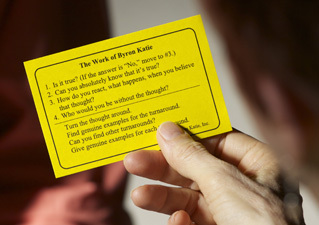With Byron Katie’s The Work
“In 1986 Katie was a mother of three, on her second marriage and had spent a decade falling into depression, agoraphobia, overeating and addiction to codeine and alcohol. They say she rarely left her bed and grew so paranoid that she sometimes slept with a loaded gun under her bed.” When she finally went to a treatment center she slept in the attic “because the other residents were afraid of her.”
Then something miraculous happened. Her entire life changed in an instant.
From Suicidal to Saint
In her own words, “I discovered that when I believed my thoughts, I suffered, but that when I didn’t believe them, I didn’t suffer, and that this is true for every human being. Freedom is as simple as that. I found that suffering is optional. I found a joy within me that has never disappeared, not for a single moment. That joy is in everyone, always.”
What happened? Katie calls it “waking up to reality.” At the same instant that she was irrevocably filled with love for everything life brings, the four questions popped into her head as a way to help others end their own suffering as well. Before long, these four questions—which she calls “the work”—were indeed helping millions of people across the world.
Waking Up Can Be Simple As Asking a Few Questions
The first five steps in the process to ending suffering in any given moment are a series of questions about a thought that is bothering you. They are very simple, so it would be easy to just skim through them and not feel the power of inquiry.
If you could simply skip to the last few steps, you would not be experiencing suffering—you would already be questioning the thought that is causing you pain. So these questions are a way to stop repressing that part of yourself that believes the thought. They are for awareness—you get to keep the thoughts if you want them, or you get to let them go. It is up to you. Therefore it is useful to do a thorough investigation of what you are thinking in the moment and acknowledge the feelings that arise, even if you are going through the process quickly.
Step 1: Think of a time that you were really upset with someone, and imagine that specific instance in your mind. If there are many different judgements, pick one (you can go back and do the others afterwards) and go on to step 2.
Step 2: Ask yourself: Is it true? (Yes or no. If no, move to Step 4.)
Step 3: Ask yourself: Can you absolutely know that it’s true? (Yes or no.)
Step 4: Ask yourself: How do you react, what happens, when you believe that thought?
Step 5: Ask yourself: Who would you be without the thought?
Turning Your Life Around
The last three steps are, in my opinion, the most powerful aspect of “The Work.” For these, you turn your original thought around to yourself, to the other person, and to the opposite, and look for specific examples that demonstrate the truth of the turnaround. The effect is a powerful sense of loosening the pain caused by the original thought, grounded in your own experience, and an opening to a more loving attitude.
This is fairly simple in practice. For this example, we will assume that the original disturbing thought is “he hurt me.”
Step 6: Turn the thought around to yourself. Eg: “I hurt me.” Now find three examples of how you hurt yourself—looking first in that specific situation, and then in your life in general.
Step 7: Turn the thought around to the other: Eg: “I hurt him.” Again find three examples of how you hurt him, beginning with that very instant you imagined in step 1.
Step 8: Consider the opposite of the first thought. Eg: “He didn’t hurt me,” or “He helped me.” Now look for three more specific examples of how this is true, and you are done.
How do you feel now?
Give this process a try whenever you are feeling less-than-happy. I imagine you will be surprised at how effective it is in opening you to a loving, happy experience of the moment.
Want to Go Further?
If you’d like more information, go to The Work’s official website, where they have many free resources and even a hotline for guidance on how to do the process. There are plenty of free YouTube videos outlining specifics and giving examples. You can also download the following apps:
iPhone App: https://itunes.apple.com/us/app/the-work-app/id478610069?mt=8
iPad App (more robust): https://itunes.apple.com/us/app/judge-your-neighbor-worksheet/id587611495?mt=8

